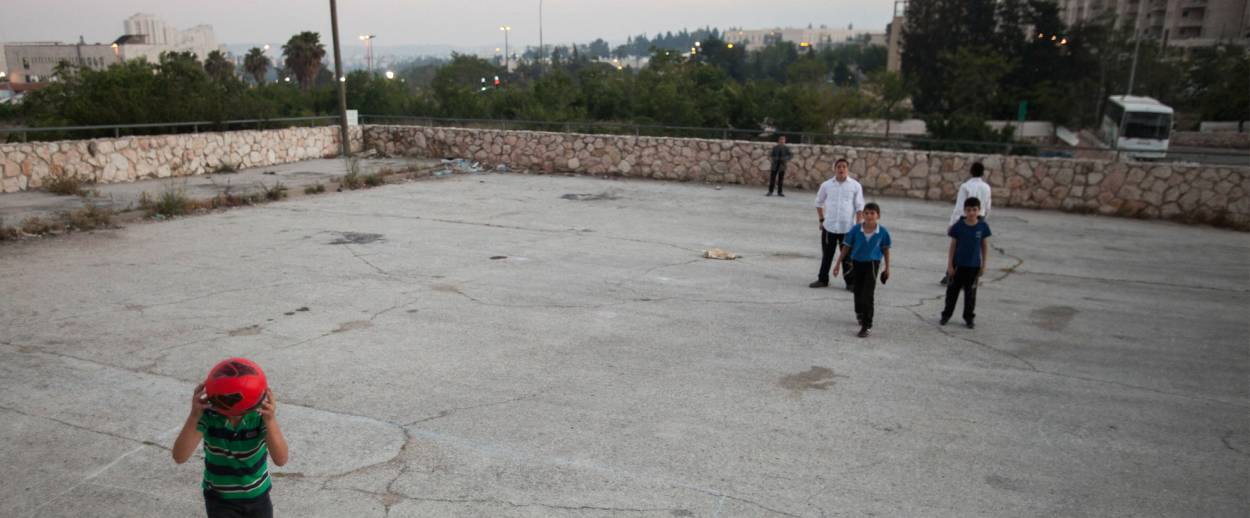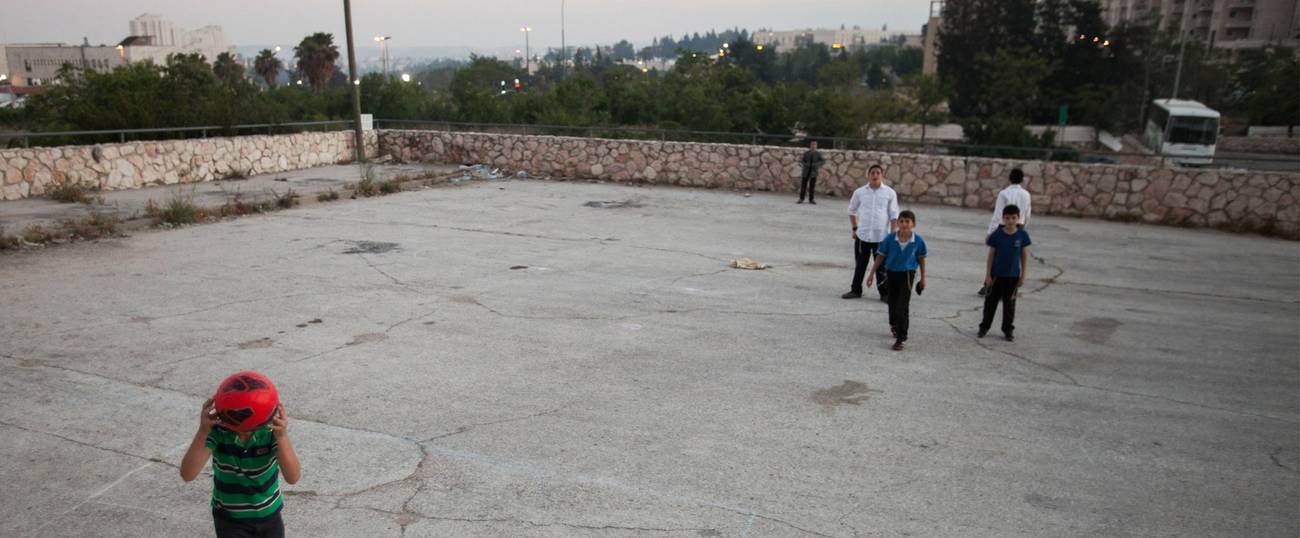Jerusalem, Spring 2015: What Is Normal Here?
A love letter to the mundane Holy City




This is the opening section of Matti Friedman’s essay about Jerusalem, presented by Tablet for Yom Yerushalayim. To read the full essay, with photographs by Dan Balilty, click here.
***
Before dawn one day early last year, I tagged along with a garbage truck picking up trash around the southern part of Jerusalem. The crew was Jewish and Arab, and so was the trash. (“Everyone eats the same potatoes,” one of the crew chiefs told me.) Spending time on the truck seemed a good way to make a point missed by most observers—that beneath the famous image of a place always on the brink, a kind of cohesion had quietly taken hold. I described that morning here.
A few months later came the events of the summer of 2014: the murder of three Jewish teenagers south of the city, the murder of a Palestinian teenager snatched from a Jerusalem street, and then rocket sirens, more attacks, and the worst spate of harassment and vandalism the city had seen in years. I had written about the growing presence of Palestinians in Jewish areas, shopping, riding the light rail from home to work; they disappeared overnight. The city’s pieces withdrew into themselves. Some predicted a new intifada.
That hasn’t happened. Things have slowly returned to normal, to the extent that “normal” could be said to describe Jerusalem. But the events of the summer and fall badly shook Jerusalemites. Past waves of violence in the city, and particularly the years of suicide bombings between 2000 and 2004, were awful, but few of the attacks were perpetrated by people from Jerusalem. This time the Jewish teenagers beating up Palestinians downtown were locals. The Palestinian men crashing their cars into commuters at light rail stops were locals. The presence of these extremes on our own streets was laid bare.
There was something intimate about the violence that made it feel rotten. In October, Moataz Hijazi from the neighborhood of Abu Tor approached Yehuda Glick, an activist for Jewish prayer on the Temple Mount, as Glick stood on a street not far from where I live. Hijazi drew a pistol and shot him four times for threatening the Islamic holy sites, but first he addressed Glick by name and apologized to him in Hebrew. It felt like an affair among neighbors.
So how do we see Jerusalem now? Is it a place headed for integration or disintegration? As someone who has lived his entire adult life here—not in a city of big ideas like “redemption” or “peace,” but in the city of supermarkets and kindergartens—and as someone with no plans to leave, the soul of Jerusalem is of more than journalistic interest to me. Talking about ordinary people in Jerusalem often feels like talking about people who work at the zoo: No one comes to see the people. They just block the view of the leopards. But daily life is important, and the social chemistry of a place is important. Since the summer I have been trying to pay closer attention to the real city inside and outside the bubble of my everyday routine. And over the last month I set out across Jerusalem from north to south, wondering what I would find.
***
I live in Talpiot, a quiet Jewish area of low buildings, cypress, trees, and kids, near the light industrial zone in south Jerusalem. On the far edge of the city, the opposite of my neighborhood in nearly every way, is the Shuafat refugee camp, where the dominant features on the main drag are chaotic traffic, potholes, refuse, and the occasional teenage drug dealer in track pants. The neighborhood is inside Jerusalem’s municipal borders in name but not in practice, a place too dangerous for city garbage men or police. When the West Bank barrier was built a decade ago to keep out Palestinian attackers, this area was left on the other side, cut off from the city by a concrete wall and accessible through a checkpoint.
“Whoever has money leaves,” said Jamil Sanduka, a father of four and a snake-catcher by trade, who was showing me around. “We have plenty of illegal weapons, drugs, and garbage, but no roads, no services, and no future for our children.”
Sanduka maneuvered his car among girls in uniform tunics pouring from a U.N. elementary school onto the road; there are no sidewalks. We passed the Abu Obeideh mosque, a sign for the Al-Filastin Culture Festival, Tawfiq Sweets, a few cell-phone shops. We might have been in Cairo. There was no sign of Israeli sovereignty, no Hebrew. There was no law at all. Garbage burned in empty lots and along the wall. After a while it was hard even to picture the rest of the city, just a few hundred yards away.
After the barrier went up City Hall wrote the neighborhood off, Sanduka said, along with the approximately 80,000 Palestinians with Jerusalem residency papers who were left outside. (Of Jerusalem’s 830,000 residents, just over a third are Palestinians.) “They don’t want to invest one shekel in this place,” he said.
We passed a new landmark: the building where Ibrahim al-Akari lived above a store trading in used tires. On Nov. 5, al-Akari left home in his white van, crossed the checkpoint and drove down Road 1, one of the city’s main thoroughfares. He swerved into a group of people near a light rail stop, killing a teenager, a police officer, and a 60-year-old man, before he was shot by another policeman. According to al-Akari’s family, he had been watching television and saw Israeli police enter the al-Aqsa mosque to quell a disturbance—a desecration, in his eyes. He snapped.
Isolation and neglect have put unbearable pressure on residents, Sanduka said as we passed al-Akari’s building. He believes there are at least 2,000 illegal weapons in the camp, which is increasingly run by criminals. He sees more support for Hamas these days, he said, and on Facebook has noticed growing sympathy for the Islamic State. He spoke to me in excellent Hebrew. A decade ago, exercising the right granted to east Jerusalem Palestinians, Sanduka became an Israeli citizen. More residents are doing the same, he said—it makes it easier to work and move around. Israeli citizenship, unlike the residency papers held by most of the city’s Palestinians, can’t be revoked.
I asked if his neighbors were pulled more toward Hamas or toward Israel. He shrugged: “Both,” he said. He meant not just that some people were pulled toward one or the other, but that sometimes the same people could be pulled both ways. In east Jerusalem, it is possible to apply for Israeli citizenship and learn Hebrew, adopt an outlook that sees Israel as a transient evil and a blight on the purity of the Islamic world, and have dozens of peaceful interactions with Israelis every day.
The usual way of describing this city, in binary terms—east/west, Israeli/Palestinian, peace/war—is not very helpful, and understanding things means holding contradictory ideas in your head at once. In November, for example, after two Palestinians from the neighborhood of Jabel Mukaber murdered four worshippers and a policeman at a synagogue, the wounded were rushed to hospital and treated by a Palestinian surgeon from the same neighborhood as the attackers. Yehuda Glick, shot in the name of Muhammad, survived to thank his doctors, including a Jerusalem Palestinian named Muhammad. A neighborhood near mine, Sur Baher, has a strong Hamas presence and a community center funded by Israel, inaugurated with a ceremony at which Palestinian kids in keffiyehs danced on a stage adorned with Israeli flags. Some residents tried to burn the center down. Others called the Jerusalem fire department. One resident is a Hamas leader. Another, himself a religious Muslim, is completing a doctorate at Hebrew University on Hebrew grammar in the time of the medieval Jewish sage Saadia Gaon.
The city is, in other words, a complicated place. This is something Ibrahim al-Akari would have learned had he lived long enough to know the identity of his victims. Of the three people he killed only one, the teenager, turned out to be a Jew. The policeman was a Druze Arab. The 60-year-old man al-Akari ran over was a Palestinian like him.
This is the opening section of “Jerusalem, Spring 2015,” a Tablet special essay about Jerusalem, in celebration of Yom Yerushalayim. It can be read in its entirety, with multimedia, for free, by clicking here.
Matti Friedman is a Tablet columnist and the author, most recently, of Who by Fire: Leonard Cohen in the Sinai.